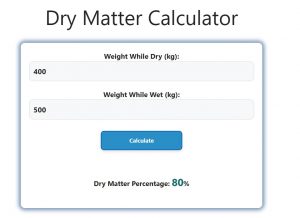About Dry Matter Calculator (Formula)
Dry matter (DM) refers to the portion of a substance that remains after all the water has been removed. It is commonly used in agriculture and food processing industries to measure the nutritional content of feed, crops, and other products. Understanding dry matter is crucial for analyzing food quality and storage, ensuring accuracy in nutritional formulations, and optimizing production processes. This article will guide you on how to use a dry matter calculator and provide answers to frequently asked questions.
Formula
The formula for calculating dry matter percentage (DM%) is as follows:
DM% = (Dry Weight / Wet Weight) * 100
Where:
- DM%: Dry Matter Percentage
- Dry Weight (DW): The weight of the substance after drying, typically measured in grams or kilograms.
- Wet Weight (WW): The original weight of the substance before drying.
How to Use
- Weigh the Wet Sample: Before drying, measure the weight of the sample (wet weight) using a scale.
- Dry the Sample: Use an oven or air-drying method to remove moisture from the sample until it reaches a constant weight.
- Weigh the Dry Sample: After drying, measure the sample again to get the dry weight.
- Apply the Formula: Plug the dry weight and wet weight values into the formula to calculate the dry matter percentage.
Example
Let’s say you have a sample of hay with a wet weight of 500 grams, and after drying, the dry weight is 400 grams. Using the formula:
DM% = (400 / 500) * 100 = 80%
This means that the hay contains 80% dry matter.

FAQs
- What is dry matter used for?
Dry matter is used to evaluate the nutritional content of animal feed, crops, and other food products. It helps in determining the moisture content and the quality of the product. - Why is dry matter important in feed analysis?
Dry matter is crucial in feed analysis because it provides an accurate measurement of the nutrients present without the dilution effect of water. - How do I convert wet matter to dry matter?
Use the formula DM% = (Dry Weight / Wet Weight) * 100 to convert wet matter to dry matter by calculating the percentage of dry material. - Can I measure dry matter at home?
Yes, you can measure dry matter at home using a kitchen scale and an oven to dry the sample until it reaches a constant weight. - Is the dry matter percentage the same as moisture content?
No, dry matter percentage and moisture content are complementary. To calculate moisture content, subtract the dry matter percentage from 100. - What types of products require dry matter calculation?
Dry matter calculations are commonly used for animal feed, crops, grains, and some food products like cheese and dried fruits. - How accurate is the dry matter calculation?
The accuracy of dry matter calculation depends on how precise the weighing and drying processes are. It’s essential to dry the sample completely and use an accurate scale. - Can dry matter affect the shelf life of a product?
Yes, a higher dry matter percentage generally means a lower moisture content, which can extend the shelf life of certain products by preventing microbial growth. - What happens if a sample isn’t dried properly?
If a sample isn’t dried thoroughly, the calculated dry matter percentage will be inaccurate, leading to potential misjudgments in nutritional content or storage requirements. - How is dry matter related to energy content in feed?
Dry matter is closely related to energy content because the nutrients that provide energy are found in the dry portion of the feed, not in the water. - Can I use dry matter calculations for liquids?
Dry matter calculations are primarily used for solids, but they can be applied to some liquids like milk or juice by measuring the weight of the solids after removing the water. - What tools do I need to measure dry matter?
You will need a scale, an oven (or air-drying method), and containers to hold the samples during the drying process. - Can dry matter affect the price of animal feed?
Yes, feed with higher dry matter content is generally more nutrient-dense and may be priced higher due to its increased value. - Is there a standard drying method for measuring dry matter?
The drying method may vary depending on the type of product, but oven-drying at a specific temperature for a set duration is a common approach. - Does temperature affect dry matter measurement?
Yes, temperature plays a significant role in drying samples. If the temperature is too high, it may lead to loss of volatile nutrients, skewing the results. - How does moisture content affect dry matter?
Higher moisture content means lower dry matter. As moisture is removed, the dry matter percentage increases. - What is a good dry matter percentage for animal feed?
A good dry matter percentage for animal feed varies by type, but typically, values above 85% are considered nutrient-rich. - Can dry matter be affected by environmental factors?
Yes, humidity and temperature can affect the drying process and the overall dry matter percentage. - How long does it take to dry a sample completely?
The time to dry a sample depends on the method and the type of material. Some samples may take a few hours, while others might require longer drying times. - Is dry matter the same as total solids?
Yes, dry matter is essentially the same as total solids, representing the material remaining after water has been removed.
Conclusion
Calculating dry matter is an essential task for anyone involved in agriculture, food processing, or nutrition analysis. By understanding how to measure dry matter, you can assess the nutritional value and quality of various products. Using the Dry Matter Calculator simplifies this process, providing quick and accurate results that can help guide important decisions in feed formulation and food storage.
Related: Dog Whelping Calculator
